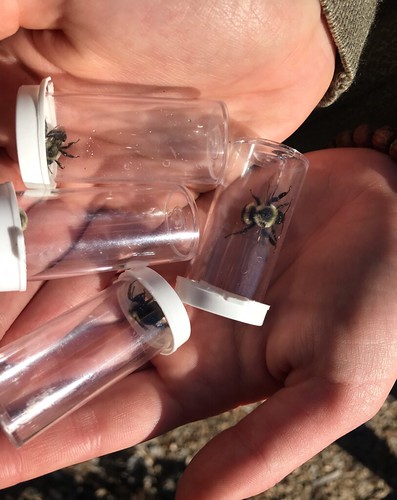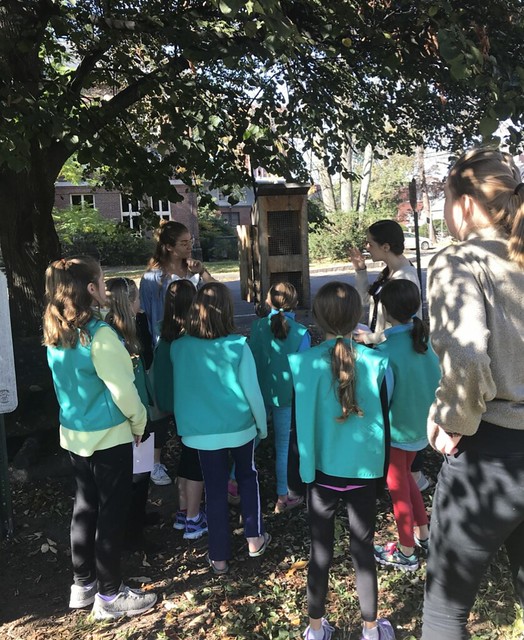Rachel Bell GRAD SCHOOL DIARIES
Insects Conservation Girl Scouts
Grad Students Meet Girl Scouts Part 2: Conserving Local Bee Habitats, One Person at a Time!
Post co-written with Alison Fowler
Here at TLS, one of our goals is to share the scientific world we hold so near and dear with those around us. So naturally, we jumped at the chance to help local Girl Scout troops achieve the Animal Habitats Badge in October 2017. You can find out more about all of the fun activities we did at the Animal Habitats Badge event here (PART 1). Alison Fowler, Elsa Cousins, and I had the chance to run an activity exploring bee habitats and the importance of bee conservation.

Figure 1 While learning about the amazing diversity of bees, the scouts got to meet bumble bees from Alison’s insect ecology laboratory. (Photo credit: Eve Beaury)
When most people think of a bee, they usually imagine honey bees making honey and living in a beehive with their queen. There are actually thousands of species of bees all over the world, living in a huge variety of habitats from mountaintops to the tropics. Additionally, most bees don’t make honey or live in colonies, instead leading solitary lives! There are also misconceptions about what types of bees sting; Alison works with bees in her lab and was able to talk to the scouts about how only female bees sting, as they are responsible for defending eggs and larvae from potential predators [1]. Nonetheless, they likely won’t sting you at all unless they’re feeling threatened!
Bees are not just fascinating organisms: they are also incredibly important to humans! Roughly one third of the crops we eat are pollinated by bees [2]. Bees rely on “rewards” from flowers, such as nectar and pollen, as their main food source. Though bees are valuable to agricultural industries, they also maintain our natural ecosystems by preferencing and pollinating native plant species. Without these native plants, animals and other organisms that rely on them would be threatened, and entire ecosystem structures could collapse. Though there are many types of pollinators globally, many plants rely heavily on bee species specifically for their reproduction.

Figure 2 After finding out that gardens filled with native flowering plants are great bee habitats, the scouts went on a bee-themed scavenger hunt in UMass Amherst’s own Franklin Permaculture Garden! (Photo credit: Eve Beaury)
Unfortunately, bee populations are declining around the world. As people continue to eliminate native landscapes to build urban infrastructure and make room for agriculture, the species of flowering plants that bees rely on are rapidly disappearing. Even when small habitat patches remain, the distance between them makes it challenging for bees to find enough flowers to support their energetic needs. This loss of continuous, undisturbed environments is also known as habitat fragmentation. Pesticide use, particularly in agriculture but also in home gardening, can also be extremely harmful to bee health and weaken their immune systems. These factors make bees more susceptible to diseases and other environmental stressors, and can contribute to a phenomenon known as Colony Collapse Disorder in honey bees, which is the large-scale, unexplained loss of honey bee colonies [3].
Though the issues bees are facing may seem somewhat daunting, there are many ways to help conserve local bee populations from your own backyard! One of the best (and easiest!) ways to help restore bee habitats is to grow a wide variety of native flowering plants in your yard! Most states have government-run webpages that list flowering plants native to that region. If you don’t have a good place at home to plant flowers, consider working with your neighbors and friends to create a community garden. Additionally, be sure to keep pesticides far away from your plants and use non-toxic pest-control solutions instead, such as garlic. Building a bee hotel can provide shelter for solitary bees, and help them survive through the winter. There are multiple ways to make safe homes for solitary bees, including drilling holes in wooden blocks or bricks, or assembling small clusters of hollowed-out twigs.

Figure 3 The scouts also had the chance to visit UMass Amherst’s bee hotel to learn about solitary bees. (Photo credit: Eve Beaury)
During the Animal Habitats Badge event, we showed the scouts that although bees are in trouble, there are so many ways to help! By engaging in a fulfilling hobby like gardening or participating in community events like building bee hotels, you too can help conserve bee habitats in your area.
Here are some more resources on what you can do to help bees:
- A child-friendly site featuring more great tips on how to support bee populations: https://savebees.org/
- A webpage showing you how to identify bee species living in Massachusetts: https://www.massaudubon.org/learn/nature-wildlife/insects-arachnids/bees-wasps/types-of-bees-wasps-in-massachusetts
- A handy guide filled with gardening, bee identification, and citizen science resources: http://ecoipm.org/native-pollinators/links/
- A website dedicated to bee and conservation knowledge: http://www.buzzaboutbees.net/
If you are interested in participating in a TLS outreach event in the future, please contact tlsoutreachandcomm@gmail.com for more information.
References:
[1] Buzz About Bees: Bee Sting Facts. (2017). https://www.buzzaboutbees.net/bee-sting-facts.html
[2] Klein A.M., Vaissière B.E., Cane J.H., Steffan-Dewenter I., Cunnigham S.A., Kremen C., Tscharntke T. Importance of pollinators in changing landscapes for world crops Proceedings of the Royal Society, 274(2007), pp. 303-313
[3] vanEngelsdorp D, Evans JD, Saegerman C, Mullin C, Haubruge E, et al. (2009) Colony Collapse Disorder: A Descriptive Study. PLoS ONE 4(8): e6481. doi:10.1371/journal.pone.0006481
